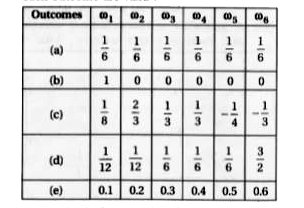Complete Solutions to Textbook Illustrations for Practice Work of chapter PROBABILITY of Class 11 book with complete answers and questions
| Class 11 | MATHS |
| Chapter | PROBABILITY |
| KUMAR PRAKASHAN | Textbook Illustrations for Practice Work |
| Number Of Questions | 19 |
| Academic Year | 2023-24 |
Two coins (a one rupee coin and a two rupee coin) are tossed once. Find a sample space.
View SolutionFind the sample space associated with the experiment of rolling a pair of dice (one is blue and the other red) once. Also, find the number of elements of this sample space.
View SolutionIn each of the following experiments specify appropriate sample space
(i) A boy has a 1 rupee coin, a 2 rupee coin and a 5 rupee coin in his pocket. He takes out two coins out of his pocket, one after the other.
View SolutionIn each of the following experiments specify appropriate sample space
A person is noting down the number of accidents along a busy highway during a year.
View SolutionA coin is tossed. If it shows head, we draw a ball from a bag consisting of 3 blue and 4 white balls, if it shows tail we throw a die. Describe the sample space of this experiment.
View SolutionConsider the experiment in which a coin is tossed repeatedly until a head comes up. Describe the sample space.
View SolutionConsider the experiment of rolling a die. Let A be the event 'getting a prime number', B be the event 'getting an odd number'. Write the sets representing the events (i) A or B (ii) A and B (iii) A but not B (iv) 'not A.
View SolutionTwo dice are thrown and the sum of the numbers which come up on the dice is noted. Let us consider the following events associated with this experiment
A : 'the sum is even'
B : 'the sum is a multiple of 3'.
C: 'the sum is less than 4'
D: 'the sum is greater than 11'.
Which pairs of these events are mutually exclusive ?
View SolutionA coin is tossed three times, consider the following events.
A : 'No head appears,
B : 'Exactly one head appears' and
C: 'At least two heads appear'.
Do they form a set of mutually exclusive and exhaustive events?
View SolutionLet a sample space be `S={omega_(1),omega_(2),.........,omega_(6)}`. Which of the following assignments of probabilities to each outcome are valid ?

View SolutionOne card is drawn from a well shuffled deck of 52 cards. If each outcome is equally likely, calculate the probability that the card will be
(i) a diamond (ii) not an ace (iii) a black card (i.e., a club or, a spade) (iv) not a diamond (v) not a black card.
View SolutionA bag contains 9 discs of which 4 are red, 3 are blue and 2 are yellow. The discs are similar in shape and size. A disc is drawn at random from the bag. Calculate the probability that it will be (i) red, (ii) yellow, (iii) blue, (iv) not blue, (v) either red or blue.
View SolutionTwo students Anil and Ashima appeared in an examination. The probability that Anil will qualify the examination is 0.05 and that Ashima will qualify the examination is 0.10. The probability that both will qualify the examination is 0.02. Find the probability that
(a) Both Anil and Ashima will not qualify the examination.
(b) Atleast one of them will not qualify the examination and
(c) Only one of them will qualify the examination.
View SolutionA committee of two persons is selected from two men and two women. What is the Probability probability that the committee will have (a) no man ? (b) one man ? (c) two men?
View SolutionOn her vacations Veena visits four cities(A, B, C and D) in random order. What is the probability that she visits
(i) A before B? (ii) A before B and B before C?
(iii) A fist and B last? (iv) A either first or second? (v) A just before B?
View SolutionFind the probability that when a hand of 7 cards is drawn from well sheffled deck of 52 cards, it contians (i) all kings (ii) 3 Kings (iii) atleast 3 Kings.
View SolutionIf A, B C are three events associated with a random experiment, prove that `P(AcupBcupC)=P(A)+P(B)+P(C)-P(AcapB)-P(AcapC)-`
` P(BcapC)+ P(AcapBcapC)`.
View SolutionIn a relay race there are five teams A, B, C, D and E.
(a) What is the probability that A, B and C finish first, second and third, respectively.
View SolutionIn a relay race there are five teams A, B, C, D and E.
(b) What is the probability that A, B and C are first three to finish (in any order) (Assume that all finishing orders are equally likely)
View Solution
Textbook Illustrations for Practice Work questions and complete solutions for chapter PROBABILITY of KUMAR PRAKASHAN KENDRA MATHS (GUJRATI ENGLISH) of Class 11
All Exercises from KUMAR PRAKASHAN Class 11 MATHS PROBABILITY
- EXERCISE : 16.1
- EXERCISE : 16.2
- EXERCISE : 16.3
- Miscllaneous Exercise : 16
- PRACTICE WORK
- Question of Module
- Solutions of NCERT Exemplar Problems (Fillers)
- Solutions of NCERT Exemplar Problems (Long Answer Type Questions)
- Solutions of NCERT Exemplar Problems (Match the followings
- Solutions of NCERT Exemplar Problems (Objective type Questions)
- Solutions of NCERT Exemplar Problems (Short Answer Type Questions)
- Solutions of NCERT Exemplar Problems (True/False)
- Textbook based MCQs
- Textbook Illustrations for Practice Work